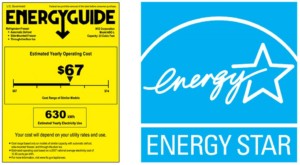 Purchasing an ENERGY STAR appliance not only cuts utility costs; it also protects the environment. Founded in 1992 by the Environmental Protection Agency, the ENERGY STAR Program was designed to help Americans save money, lower carbon emissions, and achieve energy independence by promoting ultra-efficient home products.
Purchasing an ENERGY STAR appliance not only cuts utility costs; it also protects the environment. Founded in 1992 by the Environmental Protection Agency, the ENERGY STAR Program was designed to help Americans save money, lower carbon emissions, and achieve energy independence by promoting ultra-efficient home products.
According to the National Academy of Science, roughly 20 percent of America’s greenhouse gas comes from heating, cooling, and powering our homes. Given the size of the country, even a small decrease in energy consumption would have enormous benefits, both for our environment and cost of living. Since the beginning of the program, ENERGY STAR appliances have saved:
- 5 trillion kilowatt-hours of electricity
- $500 billion in household energy costs
- 4 billion metric tons of CO2 emissions
The success of the ENERGY STAR Program has encouraged businesses and utilities to invest more heavily in energy-efficient products and infrastructure. Today, there are over 65 appliances with ENERGY STAR certifications, including ovens, boilers, dryers, furnaces, dishwashers, ceiling fans, computers, televisions, refrigerators, air conditioners, and water heaters.
How Does an Appliance Qualify for the ENERGY STAR Program?
Walk into any hardware store or appliance chain and you’ll see products sold as “energy efficient.” But while they may consume less energy than a standard appliance, they don’t deliver nearly as much savings as an ENERGY STAR appliance. To qualify, devices need to:
- Save substantial energy compared to standard models (10-50% on average)
- Provide the same features and benefits as conventional appliances
- Offset higher purchase costs by cutting household energy bills
- Achieve better results through widely available technology
Before receiving an ENERGY STAR Certificate, products undergo rigorous testing at an EPA laboratory, which measures their power consumption and confirms there is no trade-off between savings and performance. Test results are then reviewed by an independent panel accredited to international standards, which then certifies the product. Testing continues even after the product has been released, to ensure quality standards continue to be met.
How Much Can You Save by Switching to ENERGY STAR Appliances?
All ENERGY STAR Appliances provide significant savings over standard ones. In some cases, the lifetime savings in water and electricity consumption is enough to offset the purchase price of the unit. For instance:
- Dehumidifiers use more energy than your refrigerator, dishwasher, and washing machine combined. An ENERGY STAR model uses 15 percent less energy than a conventional model and saves approximately $175 over the course of its lifetime ‒ the approximate retail price of most dehumidifiers.
- Furnaces with an ENERGY STAR certificate consume fifteen percent less energy than baseline models and can cut heating costs by up to $80 every year. The best ENERGY STAR furnaces can save you more than $1,300 over their lifespan.
- ENERGY STAR refrigerators use 15 percent less energy than conventional fridges and consume roughly $60 of electricity over the course of a year, less than the cost of powering a 60-watt light bulb.
- LED light bulbs are the only ones with an ENERGY STAR certification. They not only last years longer than an incandescent bulb, they consume 90 percent less energy as well.
- An ENERGY STAR computer uses 25-65 percent less electricity than a standard laptop or desktop, due to better components and energy management.
- An ENERGY STAR television uses 25 percent less energy in all operating modes: sleep, idle, and active.
On top of the cost savings, the government also offers rebates on certain ENERGY STAR products, covering up to 30 percent of the purchase and installation price. So look for the ENERGY STAR label the next time you’re out shopping for a new appliance. It’s one of the best things you can do for your home, bank account, and the environment.
Save on Essential Equipment Repairs with Agway
ENERGY STAR appliances put less of a strain on your internal wiring, due to their low power demands. However, no system can operate indefinitely without suffering wear and tear. This type of damage can cause long-term problems, but isn’t covered by home insurance. Protect yourself by joining Agway. Our EnergyGuardTM Program covers your heating, cooling, and electrical systems.*
Our team is standing by in case the need for repair occurs. As soon as you contact us, we dispatch the nearest qualified repairman to your door as quickly as possible. We not only pay for labor costs, but all covered parts as well. There are no service fees or deductibles either. So contact us today to start saving on repairs!
*Coverage depends on commodity purchased.